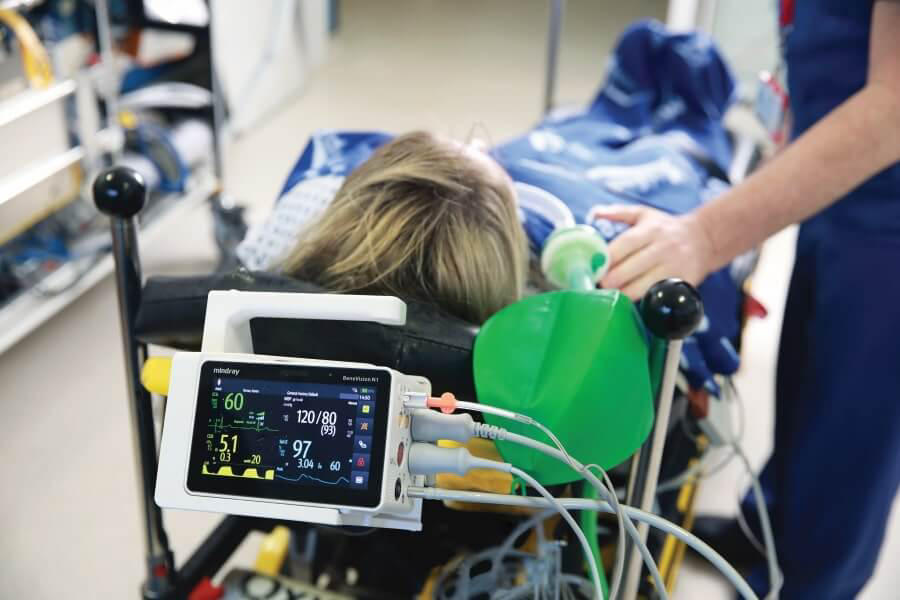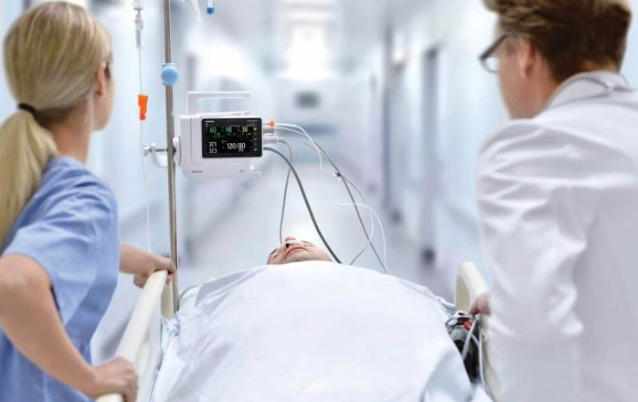From Emergency Departments (ED) and Intensive Care Units (ICU) to other areas of specialized care, critical patients often need to be moved around a hospital for additional services.
Unfortunately, this seemingly routine procedure comes with risks.
Clinicians grant patient transfer when procedures or diagnostic tests needed cannot be brought to the bedside. In many cases, a necessary step in the patient transport process is disconnecting the patient from monitoring devices because the devices are not mobile. If a patient destabilizes en route and is detached from their monitoring equipment, vital data is lost. The lost data would have given a complete medical record for clinicians to analyze and ultimately allow them to provide better care for the patient.
A 2013 study found that out of 262 intensive care patients transported, nearly half (45.8%) experienced an adverse event during the transfer, 68 (26% of all intra-hospital transports) were associated with an adverse event affecting the patient. A subsequent study two years later, which took place over six months, resulted in similar findings. The study found that eighty-two transports (44.5%) were associated with patient-related mishaps.
Because patient transports are often necessary, it is essential to have access to the most effective patient monitoring solution you can rely on during patient transport to avoid losing vital patient data.
Unmonitored Transport
Transporting is a stressful situation for patients, as they often may experience anxiety over the uncertainty of transport, upcoming specialized care, or being moved by hospital staff who are not their primary caregivers.
Staff may also find transport stressful because of the data gaps created by outdated bedside monitoring technology.
When transport occurs, the patient must be detached from their bedside monitoring device.In the event of patient deterioration, the staff in charge of transport may not know what warning signs to look for in a specific patient since they are not the patient’s primary caregiver. Unfortunately, the transport caregiver can’t leave the patient to find help once the situation has deteriorated. And without monitoring devices, auxiliary staff isn’t immediately alerted to changes in the patient’s vitals.In the event of patient deterioration during transport, there is also concern about possible litigation against the hospital. The reality of the situation is that data is lost as soon as a patient is disconnected from their monitoring device. If an adverse event happens, there’s no way to know what caused the event, or even exactly when it happened, which creates a gap in patient care and leaves the hospital vulnerable in the event of a lawsuit.
For this reason, lacking the necessary patient monitoring technology diminishes patient care and leaves providers open to litigation.

Monitored Transport
To improve care during transports, providers have begun to invest in transport monitoring systems, which provide wireless transmissions of monitoring data for patients on the move. The benefits of these transport monitoring systems are abundant. Transport monitoring during hospital transfers improves patient care by alleviating stress on the patient by ensuring their wellbeing is being tracked.
Transport monitoring also alleviates the stress that secondary caregivers face during transfers. The most effective transport monitoring systems incorporate extensive data storage with round-the-clock patient monitoring capabilities and real-time patient data available to physicians at their fingertips.
From a legal standpoint, transport monitoring can also protect a provider in litigation instances, as there is no data gap during transfers. Data gaps are a goldmine for prosecuting attorneys and potentially disastrous for providers. In insurance cases, this extra protection may even drive better reimbursement from CMS.
More importantly, having a complete data record improves overall healthcare, allowing providers to create a better picture from complete patient information.
That’s not just true for the individual patient. Leveraging electronic medical records (EMRs) can help caregivers identify the best time to move a patient, and more importantly, avoid transporting patients when they’re at their most vulnerable.
Choosing the Right Transport Monitoring Device
Clinicians know that the increased number of intra-hospital transfers poses a risk to patients. Purchasing the proper monitoring equipment for your hospital means investing in a device with the same capabilities during transport as it does bedside monitoring.
Critical features on a reliable transport monitoring device include:
- Capacitive touchscreen display with multi-gesture control
- Extensive data storage plus up to 48 hours of full disclosure
- Flexible transport solution with optional integrated or modular CO2
- Multiple mounting solutions including transport module rack with bed rail hook
- Defibrillator synchronization
- Battery run time of 8 hours

The BeneVision N1 Monitor/Module – One Monitor, Multiple Solutions
Mindray’s BeneVision N1 Monitor/Module provides clinicians with continuity of monitoring solutions to meet their most complex patient transport challenges and secures continuity of information for patients as they transition from different areas of specialized care within the hospital. With the N1’s integrated wireless capabilities and long battery life, patients will remain well-connected throughout their stay.
The N1 enables a complete patient record and helps clinicians keep patients safe during transport while also easing the logistics of ambulating. Mindray’s advanced patient monitoring solution also incorporates a straightforward design that is easy to use. Clinicians can slide the N1 from the patient’s bedside monitor and begin the process of transporting a patient. The N1 instantly converts to a wireless transport monitor, maintaining data continuity with the BeneVision Distributed Monitoring System (DMS) / EMR. When connected to the Mindray touchscreen display, the N1 provides clinicians with full bedside monitoring capabilities plus practical features like a multi-screen layout design and configurable quick keys to ease patient transfer. Mindray’s innovative transport monitoring solutions provide versatility to meet the many needs of your hospital environment.
If you are looking to purchase a reliable transport monitor, please visit us at Mindray North America. Our BeneVision N1 Monitor/Module provides continuity of monitoring and information for your patients as they transition within your enterprise, from ED to CCU, OR to PACU, ICU to unique procedures. With integrated wireless and long battery life, your patient is well-connected.
References
[1] Parmentier-Decrucq E, Poissy J, Favory R, Nseir S, Onimus T, Guerry MJ, Durocher A, Mathieu D. Adverse events during intrahospital transport of critically ill patients: incidence and risk factors[abstract]. Ann Intensive Care. 2013 Apr 12;3(1):10.
[2] Hajjej Z, Gharsallah H, Boussaidi I, Daiki M, Labbene I, Ferjani M. Risk of mishaps during intrahospital transport of critically ill patients[abstract]. Tunis Med. 2015 Nov;93(11):708-13. PMID: 27126429.




